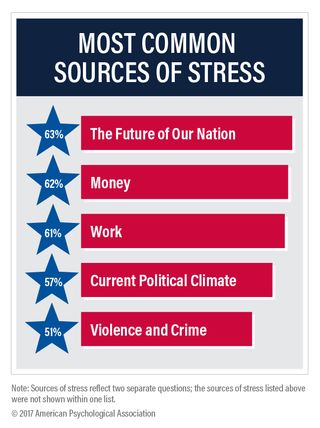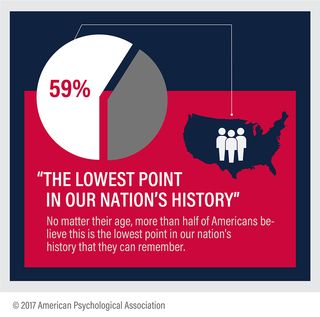Stress
Stress in America Is Gnawing Away at Our Overall Well-Being
New "Stress in America" report shows uncertainty about the future of our nation.
Posted November 1, 2017

In August of 2017, Americans were just as stressed out as we were at the same time last year—but chronic stress is increasingly eating away at our overall well-being, according to the latest “Stress in America: The State of Our Nation" survey, published today by the American Psychological Association. The latest survey of stress levels across America was conducted by Harris Poll on behalf of APA and included a diverse cohort of almost 3,500 adults (1,376 men, 2,047 women) over the age of 18, who reside in the United States. This Nov. 1, 2017, report is the first phase of data analysis regarding the survey conducted last August.
In January 2017, the APA published their “Stress in America: Coping With Change” annual report based on survey results from August 2016. This eye-opening report documented the first significant uptick in stress levels in the U.S. since the survey began 10 years ago.
Although Americans’ stress levels in 2017 are on par with 2016, the nationwide stress level of 4.8 (on a 1 to 10 scale) is still historically high. Interestingly, this year's survey found no significant difference in stress levels between the country's four regions: Americans in the East reported a stress level of 4.7; those in the South, Midwest, and West all reported stress levels of 4.8.
In my opinion, the most alarming aspect of the new 2017 report is that more survey respondents are feeling the impact of stress in their sleep patterns and day-to-day lives compared to last year. For example, almost half of all Americans (45 percent) report lying awake at night and experiencing regular sleeplessness. The latest survey also reports that 75 percent of Americans experienced at least one symptom of acute stress in the month prior to the survey. More specifically, about one-third of adults said they had experienced feeling nervous or anxious (36 percent), irritability or anger (35 percent), and fatigue (34 percent) as a result of their stress levels.
Although this study doesn't specifically analyze the psychophysiological repercussions of these statistical findings, one could speculate that the cumulative effect of chronic stress is putting Americans' hypothalamic–pituitary–adrenal axis (HPA axis) and autonomic nervous systems into hyperdrive. The psychological and physical toll of stress in America will undoubtedly continue to snowball if something doesn't change.

The latest "Stress in America" survey also found that, on average, almost two-thirds of Americans (63 percent) said the “future of the nation” is a "very or somewhat significant" source of stress. As might be expected, this number was significantly higher for Democrats (73 percent) when compared to Republicans (56 percent) and independents (59 percent). Regardless of party affiliation, when asked to think about the state of our nation in 2017, nearly six in 10 adults (59 percent) responded that the current levels of social divisiveness in the U.S. cause them distress.
Additionally, more than half of Americans (59 percent) said they consider this the “lowest point in U.S. history that they can remember.” Notably, this statistic spanned every generation, including those who lived through World War II and Vietnam, the Cuban Missile Crisis, and the September 11th terrorist attacks.
In a statement, Arthur C. Evans Jr., who is APA's chief executive officer, said:
"We're seeing significant stress transcending party lines. The uncertainty and unpredictability tied to the future of our nation is affecting the health and well-being of many Americans in a way that feels unique to this period in recent history. With 24-hour news networks and conversations with friends, family and other connections on social media, it's hard to avoid the constant stream of stress around issues of national concern. These can range from mild, thought-provoking discussions to outright, intense bickering, and over the long term, conflict like this may have an impact on health. Understanding that we all still need to be informed about the news, it's time to make it a priority to be thoughtful about how often and what type of media we consume."
On a positive note, 51 percent of Americans say that the state of our nation has inspired them to volunteer and/or support causes that reflect their core values.
In terms of lifestyle choices for coping with stress: Physical activity, listening to music, spending time with friends/family, yoga/meditation, and prayer were among the top methods of stress management.
For the first time, more than half of Americans (53 percent) see exercise as a reliable way to cope with stress. This is a noteworthy increase compared to previous years of the "Stress in America" survey.
Along this same line, another recent study published in The Journal of the American Osteopathic Association reported that working out in group fitness classes lowers stress by 26 percent and can significantly improve quality of life. The osteopathic researchers hypothesize that the face-to-face connectivity created by coming together with friends and workout buddies to do something physically challenging creates an upward spiral of overall well-being that outshines the stress-busting benefits of doing physical exercise by yourself.
References
American Psychological Association (2017). "Stress in America: The State of Our Nation." Stress in America™ Survey.
Yorks, Dayna M., Christopher A. Frothingham, Mark D. Schuenke. "Effects of Group Fitness Classes on Stress and Quality of Life of Medical Students." The Journal of the American Osteopathic Association (November 2017) DOI: 10.7556/jaoa.2017.140


